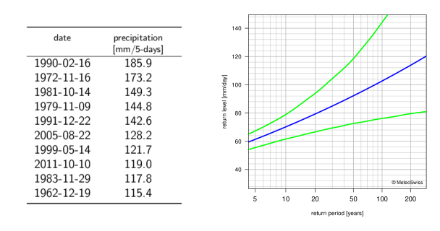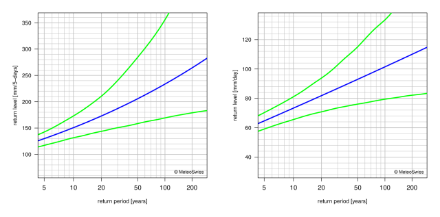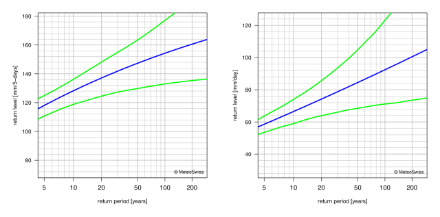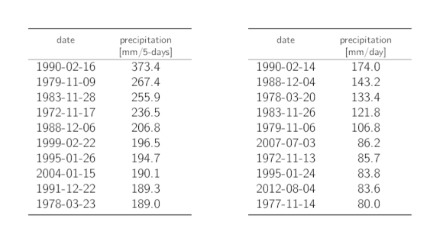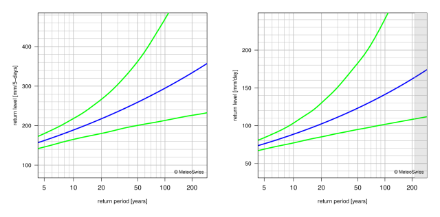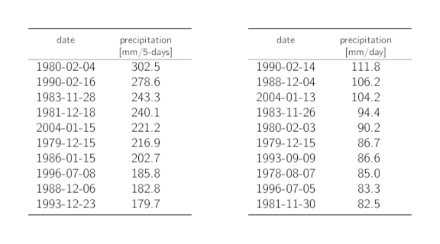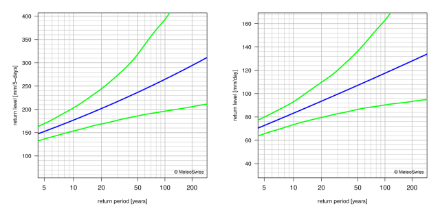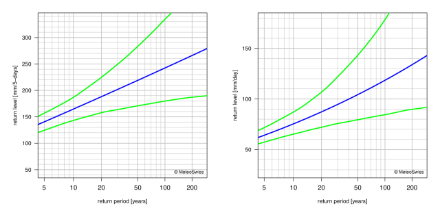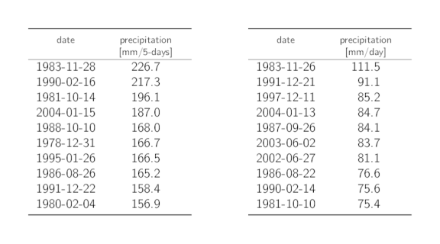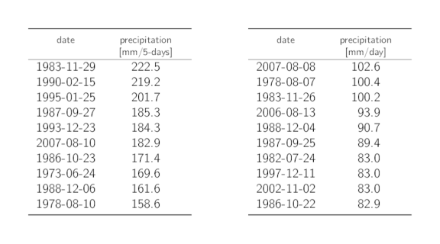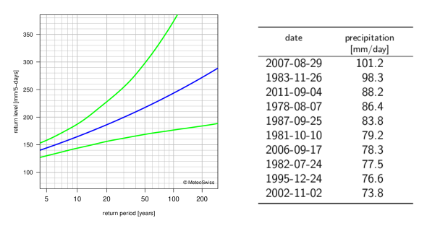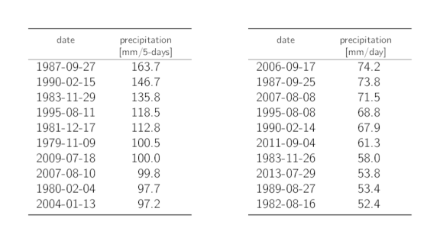Navigation des services
Recherche
Wiederkehrperioden der 5-Tages-Niederschlagssumme vom 30. April - 4. Mai
Bei diesem Ereignis erfolgten aussergewöhnlich hohe Niederschlagsmengen am Fuss und im Jura, im Mittelland, im Berner Oberland und in den Waadtländer Alpen. An einigen Stationen in diesen Regionen wurden zwischen 30. April und 4. Mai 2015 Niederschlagsmengen gemessen, die einem 10- bis 100-jährlichen Ereignis entsprechen.
Die zwischen 30. April und 4. Mai gemessene 5-Tages-Niederschlagsmenge war am höchsten an den Stationen Herzogenbuchsee (BE, 143,2 mm) und Château-d’Oex (VD, 150,9 mm) mit entsprechenden Wiederkehrperioden von 50 bis 100 Jahren. Die Mengen waren weniger hoch an den Stationen im Jura und in der Region Chablais. Diese entsprechen „nur“ einem 10- bis 50-jährlichen Ereignis.
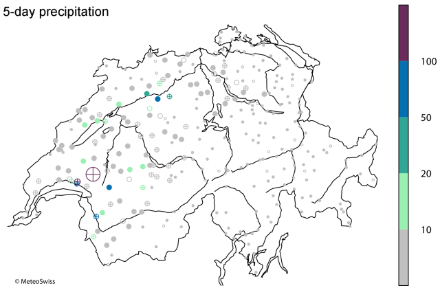
Die 5-Tages-Niederschlagssumme wurde zwischen dem 30. April 2015, 05:40 UTC und dem 5. Mai 2015, 05:40 UTC gemessen. Die Wiederkehrperioden basieren auf den Schätzungen der verallgemeinerten Extremwertverteilung aus den 5-Tages-Niederschlags-Jahresmaxima der Periode 1961-2010. Der Durchmesser der Kreise ist proportional zum Wert der Wiederkehrperiode. Die Füllung der Kreise zeigt die Zuverlässigkeit der Statistik an: gut (gefüllter Kreis), fragwürdig (Kreis mit Kreuz) und schlecht (leerer Kreis).
Wiederkehrperioden der höchsten 4-, 3-, 2- und 1-Tages-Niederschlagssummen
Da sich die meisten Niederschläge nur zwischen 30. April und 3. Mai ereigneten, sind die Wiederkehrperioden der höchsten 4-Tages-Niederschlagsmengen leicht höher als bei den 5-Tages-Niederschlagsmengen, d. h. zwischen 10 und 100 Jahren. Die höchste 4-Tages-Niederschlagsmenge wurde an der Station Herzogenbuchsee (139,4 mm) gemessen und entspricht einem 50- bis 100-jährlichen Ereignis. Niederschlagsmengen mit einer Wiederkehrperiode von 20 bis 50 Jahren wurden am Jurafuss (Riedholz-Wallierhof SO: 185,2 mm; Combe-Garot NE: 133,2 mm), im Berner Oberland (Boltigen: 168,8 mm) sowie in den Waadtländer Alpen (Gryon: 132,5 mm) und in der Region Chablais (Bex: 107,1 mm) gemessen.
Die höchsten während dieses Ereignisses gemessenen 3-, 2- und 1-Tages-Niederschlagsmengen waren weniger aussergewöhnlich als die höchsten 4-Tages-Niederschlagsmengen an einer bestimmten Anzahl Stationen auf der Alpennordseite. Sie entsprechen Wiederkehrwerten mit einer Wiederkehrperiode von 10 bis 50 Jahren. Somit scheint es so, dass nicht nur die hohen Niederschlagsmengen, die am 1. Mai in der Form von Regen niedergingen (siehe Abschnitt Niederschlag und Temperatur), sondern auch die über mehrere Tage andauernden Regenfälle dazu beigetragen haben, dass dieses Ereignis an diesen Stationen als extrem einzustufen ist.
Extremwertanalysem der 5- und 1 Tages-Niederschläge
In diesem Abschnitt wird die Extremwertanalyse für die im Abschnitt Hyetogramme aufgeführten Stationen erörtert. Mangels ausreichender Daten werden hier nicht alle Stationen aufgeführt. Die statistischen Daten wurden auf Basis der Periode von 1961 bis 2010 erhoben. Die Diagramme der Wiederkehrwerte der 5-Tages- und 1-Tages-Niederschlags-Maxima sind aufgeführt, wenn die statistischen Daten zuverlässig sind. Wenn die statistischen Daten nicht zuverlässig sind oder die Dauer der Aufzeichnungen zu kurz ist, werden stattdessen Tabellen der zehn höchsten Niederschlags-Maxima ab Beginn der Messungen bis 2014 aufgeführt. Diese können für einen Vergleich mit den Niederschlagsmengen unter Abschnitt Niederschlag und Temperatur. Zudem sind PDF-Dateien der Extremwertanalysen verfügbar, wenn die Zuverlässigkeit der Ergebnisse gut oder zweifelhaft ist.
